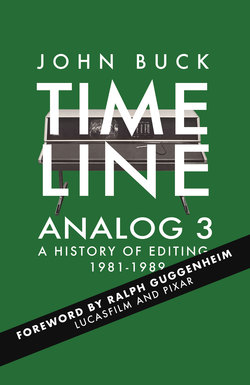Читать книгу Timeline Analog 3 - John Buck - Страница 9
На сайте Литреса книга снята с продажи.
NOVEMBER 1981
ОглавлениеThe space shuttle Columbia, piloted by astronauts Joe Engle and Richard Truly, became the first re-useable space vehicle in November 1981.
At around the same time, editing systems engineer Eloy Chairez received a call from Dave Orr, manager of Fernseh's editing division.
He asked if I would be interested in an Application Engineer position in Salt Lake City. This position was for the Editing and Machine Control products group and I would be working directly with Dave. Needless to say, I needed a job and nothing was off the table. I flew to SLC, met with Bill Butler, Dietmar Ziegar and him. I took the job and my Mach One journey continued. Dave and I spearheaded a new facelift on the Mach One and at NAB 1982 we introduced the Mach One Series II system!
The Series II introduced Slow-Motion editing to the Mach One. There was also dual channel audio control, programmable slow motion, updated edit list formatting and cluster event programming.
I remember we pulled an ‘all nighter” the day before the show opened. We were walking out as they opened the doors for the crowds on day one! We went to the hotel, showered and changed into our suits and returned to the show.
Another announcement came from CEO Bill Butler:
At my recommendation, Bosch bought out Bell and Howell’s interest and the company was renamed Robert Bosch Corporation, Fernseh Division.
Chairez adds:
We started the 1982 NAB show with name tags that had Bell & Howell/Bosch but ended the show with name tags with Bosch Fernseh.
Butler had been brough to Fernseh to streamline the US operations.
Fernseh (US) did make several important contributions to the overall Fernseh operation. First was the shorter development time, which allowed an early market entry. Several products were developed and manufactured by Salt Lake for international sales.
Second we implemented Manufacturing Resource Planning (MRP II), known today as the Demming method, which had been adopted by Japanese auto exporters in the late '60s. This gave us huge improvements in cost, on-time delivery and quality. The Salt Lake operation was one of the early US adapters of Demming, made possible by our close continuing association with the Bell & Howell manufacturing chief.
Butler recalls the next move:
Jim had come up with a design for a new system to improve on the Mach One. It incorporated a lot of the unique features such as the Active EDL and full Look-Ahead Search capability. He went to Bosch with the design.
Despite its introduction into PAL broadcast markets and Adams' new design, Mach One didn't fit with Fernseh's plans. Butler moved Chairez to Los Angles to work in Fernseh’s outside sales with companies like Chyron then made a tough decision on the man who had created the editing system.
We decided to end new development of the Mach One. I had known Jim as a key member of my engineering team at CMX Systems a decade earlier so I wished him well and released all rights of the Mach One intellectual property to him.
Jim Adams joined with development partners Joe Swiderski & Mike Shetter and sought out a new backer for their next generation editing system. Bill Butler left Fernseh in 1982 yet still had a major role to play in editing's history.
